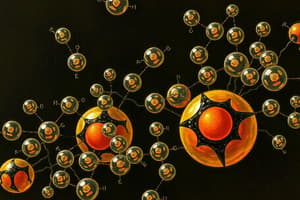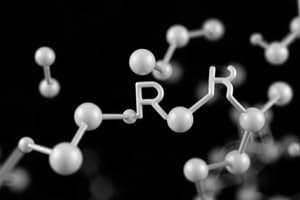Podcast
Questions and Answers
Which group do non-polar, aliphatic R groups belong to?
Which group do non-polar, aliphatic R groups belong to?
- Hydrophilic
- Hydrophobic (correct)
- Polar acidic
- Polar-neutral
All amino acids are polar in nature.
All amino acids are polar in nature.
False (B)
The one-letter symbol for tryptophan is _____
The one-letter symbol for tryptophan is _____
W
What are the three types of polar amino acids?
What are the three types of polar amino acids?
Match the following amino acids with their corresponding R-group classification:
Match the following amino acids with their corresponding R-group classification:
What is the isoelectric point (pI)?
What is the isoelectric point (pI)?
Proteins behave as zwitterions at their isoelectric point.
Proteins behave as zwitterions at their isoelectric point.
What are the ionizable groups typically found in amino acids?
What are the ionizable groups typically found in amino acids?
The amino acid __________ has an isoelectric point of 2.77.
The amino acid __________ has an isoelectric point of 2.77.
Match the following amino acids with their isoelectric points (pI):
Match the following amino acids with their isoelectric points (pI):
Flashcards are hidden until you start studying
Study Notes
Classification of Amino Acids
- Amino acids can be classified into five groups according to R-group properties: non-polar aliphatic, non-polar aromatic, and polar groups.
- Non-polar, aliphatic R groups are neutral, hydrophobic, and typically found in the interior of proteins.
- Non-polar, aromatic R groups have neutral, non-polar side chains that engage in hydrophobic interactions.
- Polar amino acids can be categorized as:
- Polar-neutral: solvent-friendly with neutral side chains.
- Polar-acidic: possess a carboxyl group in their side chains.
- Polar-basic: contain an amino group in their side chains.
Amino Acid Nomenclature
- Common names and shorthand notations (three-letter and one-letter symbols) are used for amino acids.
- Three-letter abbreviations normally start with a capitalized first letter, followed by two lowercase letters.
- When multiple amino acids share the same initial letter, the most abundant one is represented by that letter.
- Amino acids are most accurately represented in zwitterion form (having both positive and negative charges).
Isoelectric Point (pI)
- The isoelectric point (pI) is defined as the pH at which a compound has no net charge.
- Each amino acid has a specific pI based on its side chain properties, affecting its solubility and behavior in solution.
Ionizable Groups in Amino Acids
- Most amino acids possess two ionizable groups (carboxyl and amino groups) and can exhibit specific titration curves.
- Amino acids with ionizable side chains feature curves with three distinct leveling-offs due to the additional dissociable groups.
Peptides and Proteins
- Proteins exist as zwitterions and have an isoelectric point (pI) at which they carry no net charge.
- Hemoglobin: pI of 6.8, as it has balanced acidic and basic side chains.
- Serum albumin: pI of 4.9, characterized by more acidic side chains and is predominant in plasma.
Peptide Formation
- Peptides are constructed via covalent peptide bonds formed between the carboxyl group of one amino acid and the amino group of another, releasing water.
- Emil Fischer first elucidated the peptide bond concept in 1902.
Writing and Nomenclature of Peptides
- Peptides are denoted from N-terminal to C-terminal, with convention emphasizing the -NH3+ start and -COO- end.
- IUPAC nomenclature requires replacing the suffix of amino acid names (except for tryptophan) with -yl for all but the C-terminal amino acid, which retains its full name.
Examples of Peptide Names
- For the peptide Ala-Phe-Ser:
- N-terminal: Alanine
- Middle: Phenylalanine
- C-terminal: Serine
- IUPAC name: Alanylphenylalanylserine.
Practice Exercise
- Understanding the number of peptide bonds and classifying them is essential for analyzing peptide structures.
Studying That Suits You
Use AI to generate personalized quizzes and flashcards to suit your learning preferences.




